In the vise, this pattern may not look exciting, but when wet, this fly takes on a whole new personality! It's a simple pattern for complex trout. Be sure to read Steve's "Tips for the Curious Fly Tier" which explains how this pattern came about and
Steve's Tips for the Curious Fly Tier
#1 GET WET
I look at materials when they are wet, before I tie them on the fly.
Oftentimes, wet materials take on a much different appearance than when dry. When tying, I always have a clear drinking glass with some water in it nearby. I wet materials and drop them in the glass, looking at how they change. And I look at how they move when I swirl the water in the glass. This oftentimes makes me change the color of the material or sparks an idea on how to use the material more effectively in a fly pattern. Such is the case with the foam and the PeeMew Midge.
#2 PULL THE TRIGGER
I look at bugs NOT from an entomological point-of-view, but from a 'features' point of view; where I want to imitate what I think the trout is seeing.
When I tie or design a fly, I try to mimic the bugs I see in the rivers I fish. This is not to say I don't fish Adams or Royal Wulff's, but most of the time I try to give the fish something they are looking for. I try to imitate FOUR things when tying: Size, Shape, Color & "The Trigger".
What's the "trigger"? It's that one ultra feature of the real insect that may tell the trout your fly is the real thing and not just another cute pattern from the local fly shop. In the PeeMew, I think it may be two things: the subtly segmented body and the translucent wing. In the Tabou Caddis Emerger, I think it's the gangly legs and overall ugly shape of the emerging caddis. Whatever the case, look at the most popular imitative patterns on the market today and I'll bet you'll see the fish "trigger" that makes them so successful.
Before we get started, let me give credit where credit is due. The PeeMew Midge got it's name from the phonetics of the acronym PMEWE, which stands for Poudre Midge Extended Wing Emerger. It's really an adaptation of the Poudre Midge Emerger (PME), a fly tied by good friend and extremely innovative fly tier Mark McMillan of Ft. Collins, CO. After hearing about the great success Mark and others were having with his very productive fly, mainly on the Cache la Poudre River in Colorado (da Pooder), I decided to tie a few for my box. But, like most situations when I sit down to tie a pattern, I didn't have the right materials at-hand. So I improvised, following the footsteps of Mark himself (he'd be proud of me!) I didn't have any white foam to tie the real PME, so I improvised and used some thin translucent closed-cell foam sheeting I had stuffed in my travel tying kit.
While I was messing around with the thin foam in water, I noticed it becomes slightly more translucent underwater and doesn't have that semi-opaque white look like when dry. The light bulb went off in my head. Instead of tying a small post of foam as in the original PME, I thought the foam would make a better emergence wing, being more extended. So I experimented. What came about is the PeeMew Midge, marrying Mark's PME olive thread ribbing concept and my closed-cell sheet foam idea.
I still use the PME when midges aren't emerging; the pattern is deadly. But if I see midges coming off, I'll switch to the winged version, the PeeMew. Both flies have a permanent spot in my midge box. As you tie this fly, don't hesitate to get creative yourself...make the body red, or cream, or grey...midges come in all sizes and many striking colors. Tie this pattern to match the bugs in the waters you fish!
MATERIALS
| Hook | #18 - #24 curved scud hook |
| Body | black thread base with olive thread ribbing |
| Wing | closed-cell sheet packing foam |
| Head | super fine dubbing (I use midge-class SLF or natural muskrat) |
| Thread | black |
Preparation
Locate some translucent closed-cell packing sheet foam. I found mine from the packing inside some computer equipment I purchased, but most all electronics stores now throw this stuff out by the oodles. Just go to a local Big Box computer store and ask them for their trash!
Cut inch-long strips about 1/8" wide for #18 and #20 size hooks, thinner for smaller flies.
Tying the Body
(step not shown in pictures)
Tie in a piece of olive thread, size 6/0, at the bend of the hook. Wrap the hook shank with black thread and palmer the olive thread forward to the eye of the hook over the black thread base; tie off. Place the thread about 1 hook-eye length back from the hook-eye itself.

Prepare the foam wing by cutting very thin strips of closed-cell packing foam.
Placing The Wing
Double over the foam strip and place on the hook shank as shown in the first picture to the right. Hold the foam in place while you tie, as shown in the second picture.

Size up the foam strip before tying it in place.

Place the foam on the top of the hook and hold in place while tying in.
Dubbing the Head
Tie the foam in with a few secure wraps, trim the excess and dub on just a tad of black dubbing.

Allow enough space for dubbing a small head and whip finish to complete the fly. Shown here is the amount of space I leave for the dubbed head on a #18 hook.
Finishing the Fly
Tie off and trim the foam wings equal with the barb-point on the hook.

A finished PeeMew Midge takes only a minute to tie!
Slippery When Wet
Notice how translucent the closed cell foam gets when wet...neat stuff.
To make this fly more durable, add a coat of tying cement over the entire thread body just before you tie the wings on. I noticed that the body of this fly would unravel with only a few fish...but the darned wing stayed on.


When wet, the PeeMew Midge is pretty convincing.
- Log in to post comments

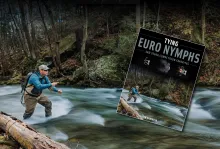
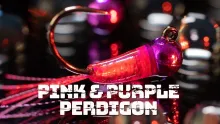

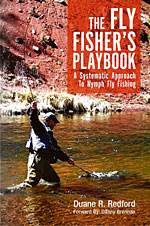
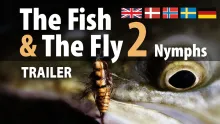
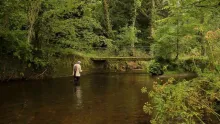

I have a very succes
I have a very successful Flying Ant and Termite Pattern tied this very same way and is coated with Super Glue . On hooks smaller than size 16 only the Gastor is represented in the forming of the body and yes remarkably the wing is very durable . This pattern was a result of a conversation that I had with Gary LaFontaine regarding the use of this type
of foam on his Bubblehead . I have experimented with the addition of legs and found that they pleased me more than the fish .
Steve: Do you cut th
Steve: Do you cut the foam wings after you tie them in to make 2 wings or just leave them in a loop?
hi steve, you mentio
hi steve, you mentioned winged version. do you tie the wings together with the foam ie just behind the foam stil keeping the foam on the fly
love this fly its re
love this fly its really good, cant wait to try them
Thank you very aktu
Thank you very aktual fly for Russian
This is one of the m
This is one of the most effective flies , l have ever used for late fall midge fishing. lt took fish when no other patterns whould. your right about the wing looking so real underwater, the big trout in the BOW RIVER in calgary sure thought it was the real mccoy. thanks for the great pattern.
Found you on Google.
Found you on Google. Not a fly-tyer yet but at 74 I'm trying. Fish the Rush River in WI. The midge hatch is spectacular but the fish are picky. It seems that the live midges bodies are a green color but once they are spent, they turn black. I am looking for a trailer emerger which might represent something like I see. Any suggestions? Thank you.
Hi Steve, i wanted t
Hi Steve, i wanted to first of all thank you for this web site. It really does fill a void. Your photos and detailed info leave little to the imagination and this is the way it should be.
I do have a couple of questions though. 1. Do you use this midge in both moving water and in still water ie.lakes etc ? In each case what fishing technique do u use? So do u use a strike indicator in one or both cases or do you prefer to fish without the indicators. Sometimes i like to grease a leader up to a certain point behind the fly and occasionally pull on the line to simulate the vertical movement one can observe the critters engage in as they make their way uo the water column. I observed this activity through the use of an aquarium. So tell me what techniqes you prefer to us and when. Thanks Mike Lombardo
Had to smile to myse
Had to smile to myself when I saw this article. My wife used to work in a greengrocery and one day came home with some avocados. They were wrapped in a similar material made as a kind of mesh...the "wire" being about 3mm. thick. I cut a 10mm length, 45 degrees at each end, tied it in at one end as a wing, carefully split it down the length and made a figure of 8 to seperate the two halves. Worked a treat! Nice visually, durable and excellent flotation!
Steve - I've enjoyed
Steve - I've enjoyed the write-ups on the caddis emerger and the midge. Keep up the good work. I live in Ft. Collins and fish the Poudre quite a bit. I'll tie some up and try them this season. Thanks.
great looking fly. i
great looking fly. i can't believe how real it looks when wet. can't wait to try it out.
its my first time do
its my first time doing fly good explication